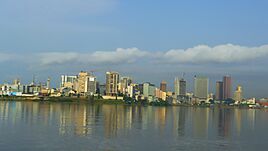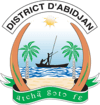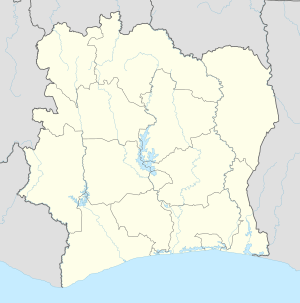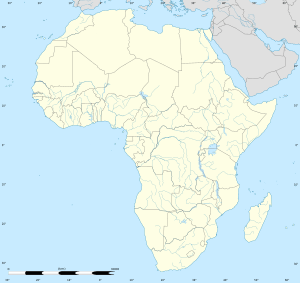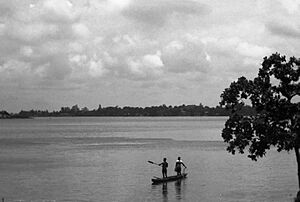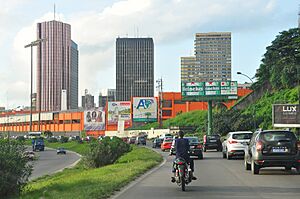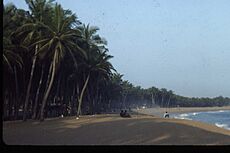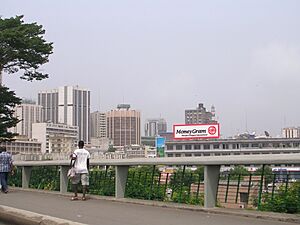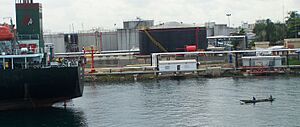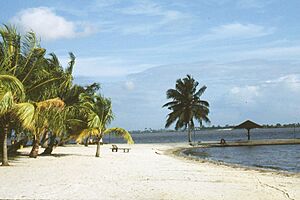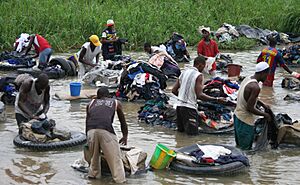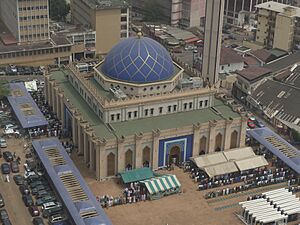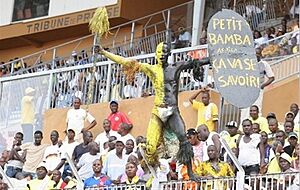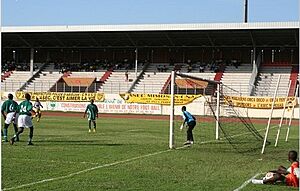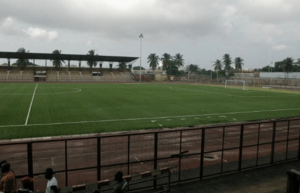Abidjan facts for kids
Quick facts for kids
Abidjan
|
|||
|---|---|---|---|
|
City and autonomous district
|
|||
| Autonomous District of Abidjan District Autonome d'Abidjan (French) |
|||
|
Plateau commune skyline
Entrance of Banco National Park
Pool of Hôtel Ivoire
Dock of Autonomous Port of Abidjan
St. Paul's Cathedral of Abidjan
Université Félix Houphouët-Boigny
Abidjan Great Mosque
Street of Koumassi commune
An avenue of Abidjan
|
|||
|
|||
| Nickname(s):
"Babi"
|
|||
| Motto(s):
"District d'Abidjan, acteur de développement"
|
|||

Map of the 10 communes which formed the former City of Abidjan (422 km2), now included in the larger Autonomous District of Abidjan (2119 km2)
|
|||
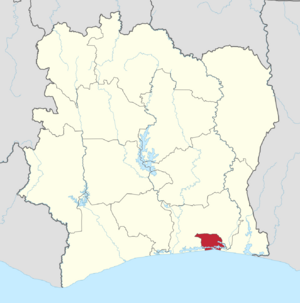 |
|||
| Country | |||
| District | Abidjan | ||
| Department | Abidjan | ||
| Area | |||
| • Total | 2,119 km2 (818 sq mi) | ||
| • City | 422 km2 (163 sq mi) | ||
| Elevation | 18 m (59 ft) | ||
| Population
(14 Dec. 2021 census)
|
|||
| • Total | 6,321,017 | ||
| • Density | 2,983.0/km2 (7,726.0/sq mi) | ||
| • City | 5,616,633 | ||
| • City density | 13,310/km2 (34,470/sq mi) | ||
| Demonym(s) | Abidjanais | ||
| Human Development Index | |||
| • HDI (2022) | 0.569 (medium) | ||
| Time zone | UTC+0 (GMT) | ||
| Area code(s) | +225 | ||
Abidjan is the biggest city and was once the capital of Côte d'Ivoire. In 2021, about 6.3 million people lived there. This makes it one of the largest cities in Africa. Abidjan is a lively place in West Africa, known for its many industries and busy city life. It's also the most populated city in Africa where people speak Dioula and French.
The city grew very fast after a new port was built in 1931. It became the capital of the French colony in 1933. When the Vridi Canal was finished in 1951, Abidjan became a very important sea port. Even after Côte d'Ivoire became independent from France in 1960, Abidjan remained the capital. In 1983, Yamoussoukro became the official political capital. However, Abidjan is still called the "economic capital" because it's the country's largest city and the center of all its business. Many government offices and foreign embassies are still in Abidjan. The Abidjan Autonomous District, which includes the city and its nearby areas, is one of the 14 districts of Côte d'Ivoire.
Contents
- How Did Abidjan Get Its Name?
- What Is Abidjan's History?
- Where Is Abidjan Located?
- Education in Abidjan
- How Is Security Handled in Abidjan?
- Abidjan's International Connections
- Who Lives in Abidjan?
- Who Are Some Famous People from Abidjan?
- What Is Abidjan's Economy Like?
- How Do People Get Around in Abidjan?
- What Can You Do in Abidjan?
- What Is Abidjan's Culture Like?
- Where Do People Worship in Abidjan?
- What Sports Are Popular in Abidjan?
- See also
How Did Abidjan Get Its Name?
The name "Abidjan" comes from a funny misunderstanding, according to old stories from the Tchaman people. The legend says that a European explorer met an old man carrying branches. The explorer asked the man for the name of the nearest village. The old man didn't understand French. He thought the explorer was asking why he was there. So, he got scared and shouted "min-chan m'bidjan" in his language, Ebrié. This means "I just cut the leaves." The explorer thought this was the village's name and wrote it down as Abidjan.
Another version of the story is simpler. When the first colonists asked a local man the name of the place, he misunderstood and said, "M'bi min djan": "I've just been cutting leaves."
What Is Abidjan's History?
Abidjan's Early Days and Colonial Times
Abidjan started as a small fishing village of the Atchan people. In 1896, French settlers moved there from Grand-Bassam because of many yellow fever outbreaks. They chose Abidjan's spot in 1898, and it officially became a town in 1903. At first, Bingerville was the capital of the French colony from 1900 to 1934.
Abidjan, located by the lagoon n'doupé (meaning "the lagoon in hot water"), had more space and better chances for trade. The port in Petit Bassam (now Port-Bouët) quickly became more important than Grand-Bassam's port. It was the main way for goods to enter the colony. By 1904, Abidjan was the main business center of Ivory Coast. It was a key place for sending products to Europe, especially with help from the growing Lebanese community.
In 1931, the areas of Plateau and what would become Treichville were connected by a floating bridge. This is near where the Houphouët-Boigny Bridge is today. Also in 1931, streets in Abidjan started getting official addresses.
Abidjan became the third capital of Ivory Coast in 1934. Before this, Grand-Bassam and Bingerville were the capitals. Many Tchaman villages had to move. The main Tchaman community leader can still be found in Adjame, which means "center" or "meeting" in Tchaman.
South of the Plateau district, the village of Dugbeo moved across the lagoon to Anoumabo. This area, known as "the forest of fruit bats," later became Treichville. It was renamed in 1934 to honor Marcel Treich-Laplène, an early explorer and administrator of Ivory Coast.
The city was planned like most colonial towns, with a grid plan. The area called Le Plateau was where the settlers lived. The northern part of the city was for the local people. A military barracks, where the courthouse is now, separated these two areas.
In the 1940s, the Bardon Park Hotel was built in Le Plateau. It was the first hotel in francophone Africa with air conditioning. Abidjan's lagoon was connected to the sea when the Vridi Canal was finished in 1950. This canal was 15 meters deep. Soon, Abidjan became a major financial center in West Africa. In 1958, the first bridge connecting Petit-Bassam Island to the mainland was completed.
Abidjan After Independence
When Côte d'Ivoire gained independence in 1960, Abidjan became the country's main administrative and economic hub. The city grew a lot in the years after independence. Its population jumped from 180,000 people in 1960 to 1,269,000 in 1978. The tall buildings you see in Abidjan today were mostly built during this time of economic success.
New neighborhoods like the fancy Cocody were created. Cocody was built in a colonial style and became home to wealthy Ivorians, foreign residents, and diplomats. It has the French embassy and the famous Hotel Ivoire. Since 2009, the largest U.S. embassy in West Africa is also in Cocody.
Construction on St. Paul's Cathedral started in 1980 and finished in 1985. From the 1980s, Abidjan faced challenges due to neglect and other issues. In 1983, Yamoussoukro became the new political capital of Ivory Coast.
Abidjan faced difficult times from 2002 to 2007 and again from 2010 to 2011. These were periods of civil unrest in the country. During these times, international peacekeeping forces were present in the city to help maintain order. After the main conflicts ended in 2011, Abidjan began to recover and grow again.
Where Is Abidjan Located?
Abidjan is on the southeast coast of Côte d'Ivoire, by the Gulf of Guinea. The city is built around the Ébrié Lagoon. The main business area, Le Plateau, is in the center. Other important areas include Cocody, Deux Plateaux (a wealthy neighborhood), and Adjamé, a busy commercial area north of the lagoon.
South of the lagoon are Treichville and Marcory. To the west are Attecoube, Locodjro, Abobo Doume, and Yopougon. Île Boulay is an island in the middle of the lagoon. Further south is Port Bouët, where the airport and main seaport are located. Abidjan is at 5°25' North, 4°2' West.
What Is Abidjan's Climate Like?
Abidjan has a tropical wet and dry climate. This means it's generally warm and humid all year. It has two rainy seasons: a long one from March to July and a short one from September to December. January, February, and August are drier months.
Even though it's a tropical climate, August is the coolest month, averaging about 24.5°C (76°F). This is because of a cool ocean current called the Benguela Current. The city is very humid, with humidity usually above 80% throughout the year.
| Climate data for Abidjan, Cote d'Ivoire | |||||||||||||
|---|---|---|---|---|---|---|---|---|---|---|---|---|---|
| Month | Jan | Feb | Mar | Apr | May | Jun | Jul | Aug | Sep | Oct | Nov | Dec | Year |
| Record high °C (°F) | 35.0 (95.0) |
35.7 (96.3) |
34.9 (94.8) |
35.0 (95.0) |
34.9 (94.8) |
36.2 (97.2) |
34.0 (93.2) |
32.0 (89.6) |
32.1 (89.8) |
32.8 (91.0) |
35.0 (95.0) |
33.7 (92.7) |
36.2 (97.2) |
| Mean daily maximum °C (°F) | 30.5 (86.9) |
31.0 (87.8) |
31.1 (88.0) |
31.2 (88.2) |
30.4 (86.7) |
28.7 (83.7) |
27.4 (81.3) |
26.9 (80.4) |
27.6 (81.7) |
29.2 (84.6) |
30.5 (86.9) |
30.3 (86.5) |
29.6 (85.3) |
| Daily mean °C (°F) | 26.8 (80.2) |
27.7 (81.9) |
27.9 (82.2) |
27.7 (81.9) |
26.9 (80.4) |
25.8 (78.4) |
24.7 (76.5) |
24.5 (76.1) |
25.6 (78.1) |
26.8 (80.2) |
27.4 (81.3) |
27.0 (80.6) |
26.6 (79.9) |
| Mean daily minimum °C (°F) | 23.5 (74.3) |
24.6 (76.3) |
24.9 (76.8) |
24.9 (76.8) |
24.6 (76.3) |
23.7 (74.7) |
22.9 (73.2) |
22.1 (71.8) |
22.3 (72.1) |
23.6 (74.5) |
24.4 (75.9) |
23.8 (74.8) |
23.8 (74.8) |
| Record low °C (°F) | 14.7 (58.5) |
16.0 (60.8) |
19.0 (66.2) |
15.9 (60.6) |
18.5 (65.3) |
18.6 (65.5) |
17.1 (62.8) |
17.2 (63.0) |
15.2 (59.4) |
17.5 (63.5) |
19.5 (67.1) |
16.5 (61.7) |
14.7 (58.5) |
| Average rainfall mm (inches) | 16.3 (0.64) |
48.9 (1.93) |
106.7 (4.20) |
141.3 (5.56) |
293.5 (11.56) |
561.8 (22.12) |
205.7 (8.10) |
36.8 (1.45) |
80.5 (3.17) |
137.7 (5.42) |
143.3 (5.64) |
75.1 (2.96) |
1,847.6 (72.75) |
| Average rainy days (≥ 0.1 mm) | 3 | 4 | 9 | 11 | 19 | 22 | 12 | 8 | 11 | 14 | 16 | 9 | 138 |
| Average relative humidity (%) | 84 | 86 | 83 | 82 | 84 | 86 | 85 | 86 | 89 | 87 | 83 | 83 | 85 |
| Mean monthly sunshine hours | 183 | 212 | 226 | 210 | 192 | 117 | 115 | 121 | 141 | 202 | 225 | 208 | 2,152 |
| Source 1: Deutscher Wetterdienst | |||||||||||||
| Source 2: Danish Meteorological Institute | |||||||||||||
| Jan | Feb | Mar | Apr | May | Jun | Jul | Aug | Sep | Oct | Nov | Dec |
|---|---|---|---|---|---|---|---|---|---|---|---|
| 28 °C (82 °F) | 28 °C (82 °F) | 28 °C (82 °F) | 29 °C (84 °F) | 29 °C (84 °F) | 28 °C (82 °F) | 26 °C (79 °F) | 25 °C (77 °F) | 25 °C (77 °F) | 26 °C (79 °F) | 28 °C (82 °F) | 28 °C (82 °F) |
How Might Climate Change Affect Abidjan?
Scientists predict that Abidjan's climate will change in the future. By 2050, its climate might feel more like Manila in the Philippines. The average yearly temperature could go up by about 1.8°C (3.2°F).
Also, Abidjan is one of 12 major African cities that could be greatly affected by rising sea levels. This could cause billions of dollars in damage by 2050 if nothing is done to prepare. Sea levels are expected to keep rising for a very long time, so preparing for this is important.
How Is Abidjan Divided?
The Autonomous District of Abidjan includes 10 central areas called communes. These used to be the old City of Abidjan. It also has 4 smaller towns outside the city: Anyama, Bingerville, Brofodoumé, and Songon.
The 10 communes of the old City of Abidjan are split into Northern Abidjan and Southern Abidjan, with the Ébrié Lagoon in between.
Communes in Northern Abidjan
- Abobo: This area has many public homes and a large population of people who have moved there for work.
- Adjamé: This commune grew from an old village. It's a very important business area for Côte d'Ivoire, with many shops and the main bus station for travel across the country.
- Yopougon: This is the most populated commune in Abidjan. It has both factories and homes. Important research centers and a hospital are located here.
- Plateau: This is the business heart of Ivory Coast, with modern, tall buildings. Even though Yamoussoukro is the official capital, many government offices, like the Presidency, are still in Plateau.
- Attécoubé: This commune contains the Banco forest, which is a national park.
- Cocody: Famous for its nice homes and neighborhoods like Deux-Plateaux and Riviera. The Université Félix Houphouët-Boigny and many private universities are here. The President of the Republic also lives in this commune, and it has many foreign embassies.
Communes in Southern Abidjan
- Koumassi: This commune has a significant industrial area.
- Marcory: Mostly a residential area, it includes the upscale Biétry and Zone 4 neighborhoods where many foreigners live.
- Port-Bouët: Home to an oil refinery and the Félix-Houphouët-Boigny International Airport. It also has a famous lighthouse. The Vridi beach area is popular on weekends, but the ocean can be rough. Since 1950, Vridi has been a major job center due to its many factories.
- Treichville: This commune is where the Autonomous Port of Abidjan is located, along with many shops and industrial areas. It also has sports facilities and the Palace of Culture.
- Île Boulay: An island in the lagoon.
Towns Near Abidjan
Some towns close to Abidjan include Jacqueville and Dabou to the west. To the north are Sikensi, Tiassalé, Agboville, Adzopé, and Alépé. To the east is Grand-Bassam. The towns of Anyama, Bingerville, Brofodoumé, and Songon are part of the larger Abidjan area.
Education in Abidjan
The Université Félix Houphouët-Boigny was started in 1964. In Côte d'Ivoire, most children go to primary school. However, only about one-third of students can continue to secondary school after a test. Abidjan has 24% of all students in the country, even though it has 20% of the total population.
Abidjan is where the main schools and universities in Côte d'Ivoire are located. These include famous high schools like Lycée Classique d'Abidjan and Lycée Sainte-Marie de Cocody. The Blaise Pascal Abidjan school is a French school. The Lycée International Jean-Mermoz also reopened after being closed for a while.
How Is Security Handled in Abidjan?
During times of civil unrest, foreign peacekeeping forces were stationed in Abidjan. The United Nations Operation in Côte d'Ivoire (UNOCI) had its main office in Attécoubé. France also has military forces in Côte d'Ivoire, with soldiers based in Port-Bouet and at the Abidjan airport. These forces help with security and counter-terrorism efforts in the region.
Police and Law Enforcement
Abidjan is divided into districts, and each has a police station. The city has both municipal police and national police. All police officers are trained at the National Police Academy in Cocody. There are special police units like the Anti-Riot Squad (BAE) and the Republican Security Company (CRS). The main base for the gendarmerie (another police force) is at Agban.
French Military Base
Abidjan is home to one of France's military bases in Africa, located in Port-Bouet. This base, called the 43rd BIMA, has thousands of people living there. It operates under agreements between France and Côte d'Ivoire.
Abidjan's International Connections
Diplomacy and International Organizations
Abidjan is a major hub for international groups. Many important organizations have their regional offices here. These include UNICEF, the UN Development Programme, the World Health Organization, and the World Food Programme. Most foreign embassies in Côte d'Ivoire are also in Abidjan. The African Development Bank (ADB), which is the largest financial institution in Africa, has its main office in Abidjan.
Sister Cities
Abidjan has "sister city" relationships with several cities around the world. This means they share cultural and economic ties.
- Tianjin, China
- Marseille, France
- São Paulo, Brazil
- San Francisco, United States
- Alfortville, France (sister city with Cocody)
- Kumasi, Ghana (sister city with Treichville)
- Pontault-Combault, France (sister city with Anyama)
- Boulogne-Billancourt, France
- Yokohama, Japan
- Basel, Switzerland
Who Lives in Abidjan?
The population of Abidjan was 6,321,017 people in 2021. The city's population has grown a lot, especially in recent years, as many people move there for jobs and a better life.
Abidjan is home to people from many different backgrounds. French is commonly spoken, and Abidjan French is a unique local dialect. Another informal French dialect called Nouchi is used by young people. The historical trading language, Dioula, is also widely understood. Many other local languages are spoken, such as Attié, Baoulé, and Bété.
How Has Abidjan Grown?
| Year | City of Abidjan (422 km2) (disbanded in 2001) |
District of Abidjan (2,119 km2) (created in 2001) |
Yearly growth |
|---|---|---|---|
| 1912 | 1,400 | — | — |
| 1928 | 5,400 | — | +8.80% |
| 1939 | 22,000 | — | +13.62% |
| 1948 | 48,000 | — | +9.06% |
| 1955 | 125,000 | — | +14.65% |
| 1963 | 254,000 | — | +8.70% |
| 1975 | 951,216 | — | +11.81% |
| 1988 | 1,929,079 | — | +5.65% |
| 1998 | 2,877,948 | 3,133,608 | +3.79% |
| 2014 | — | 4,707,404 | +2.68% |
| 2021 | — | 6,321,017 | +3.96% |
| Sources: City: 1912–1948 administrative estimates, 1955 INSEE census, 1963 SEMA demographic survey, 1975–1998 INS censuses. District: 1998 INS census, 2014 INS census, 2021 INS census. |
|||
Abidjan's population grew very quickly, especially from 1945 to 1975, doubling every six or seven years. This growth slowed down in the 1980s and 1990s but has picked up again recently. Many people move to Abidjan from other parts of Côte d'Ivoire and from neighboring countries like Burkina Faso, Mali, and Ghana. A small number of people from outside Africa, mainly Lebanese and French, also live in Abidjan.
What Languages Are Spoken in Abidjan?
The original language of the city was Ebrié. Today, the official language is French. However, people in Abidjan often speak a local version of French called français de Treichville or français de Moussa. This version has different pronunciations and slang words. Another informal language, Nouchi, is used by teenagers.
Dioula is a common language for trade and is understood by most people. Because people from all over Côte d'Ivoire live in Abidjan, about sixty different local languages are spoken, such as Attié, Baoulé, and Bété.
How Is Abidjan Built?
Modern areas like Plateau and Cocody look like European cities. They have tall office buildings and apartment blocks built from the 1970s to the mid-1980s. The CCIA building, a skyscraper, was finished in 1982.
Older neighborhoods like Treichville and Marcory still have a traditional layout. Here, homes are often close to businesses, similar to how old African villages were organized.
The Cocody district has many single-story wooden houses with large, green gardens. Some houses are even built on stilts by the Ébrié Lagoon. The city hall building is a great example of modern architecture.
Challenges with City Growth
Abidjan's population has grown very fast, doubling every seven years since 1945. Many people from rural areas come to the city looking for opportunities. Abidjan is home to 45% of all city dwellers in Côte d'Ivoire and 20% of the country's total population. It is much larger than the second-largest city, Bouaké.
Improving the City
After some past issues with waste management, Abidjan has made big efforts to improve. There are projects to clean streets, collect waste, and teach about hygiene. Roads are also being repaired and new ones built. These improvements are happening in all parts of Abidjan.
Who Are Some Famous People from Abidjan?
- Lassina Diomandé (born 1979), footballer
- Didier Drogba (born 1978), footballer
- Fatou Bolli (born 1952), novelist
- Modeste Gnakpa (born 1988), footballer
- Kader Kohou (born 1998), American football player
- Arnaud Monney (born 1981), football player
- Anderson Lago Zeze (born 1989), football player
- Christian Kouamé (born 1997), football player
- Marc Guéhi (born 2000), football player
- Amad (born 2002), professional footballer
- Ismaël Koné (born 2002), Canadian professional footballer
What Is Abidjan's Economy Like?
Abidjan is a major economic center. The main stock exchange for Côte d'Ivoire and seven other West African countries, called Bourse Régionale des Valeurs Mobilières (BRVM), is located here. Many companies, like the former Air Ivoire and Air Afrique, had their main offices in Abidjan.
What Industries Are in Abidjan?
The area around the lagoons is the most industrialized part of the country. Major industries include:
- Food processing: Making things from palm oil, fruits like pineapples and mangoes. Côte d'Ivoire is a huge producer of cocoa and coffee. Abidjan is also a top African port for tuna fishing.
- Wood: Processing wood from forests, like mahogany, for export.
- Automobiles and Textiles: Manufacturing cars and making clothes from cotton.
- Chemicals and Oil: There's a large oil refinery and an oil port, as Côte d'Ivoire produces oil offshore.
- Construction: Many big international construction companies operate here.
- Precious metals: Working with stones and precious metals for export.
A lot of the city's economy is also in the "informal economy," which means many people do small, unofficial jobs.
What About Services and Banking?
The service industry is growing in Abidjan. Many international banks and service companies have set up offices. Abidjan is the main financial center for French West Africa. The African Development Bank is headquartered here, along with many other international financial institutions like the World Bank and International Monetary Fund. There are also many national banks and insurance companies, making Abidjan a very competitive financial hub for West Africa.
Electricity and Telecommunications
Abidjan has several power plants, including the Azito thermal power plant, which provides a lot of electricity. Côte d'Ivoire produces enough electricity for itself and exports it to neighboring countries. The city also has a strong fixed telephone network and various internet providers.
How Do People Get Around in Abidjan?
Trains run from Abidjan to Ouagadougou from stations in Treichville, Abobo, and Adjamé. Ferries connect different parts of the city across the lagoon. The Félix-Houphouët-Boigny International Airport serves the city. A new metro system is also being built.
The Abidjan Transport Company (SOTRA) runs buses, taxis, and special express taxis.
Taxis
There are two types of taxis:
- Taxi-meter (red): These can go anywhere in the city.
- Woro-woro (yellow and green, blue, or orange): These are limited to specific neighborhoods.
Airport
The Port Bouet Airport is very large and can handle all types of big planes. Abidjan is only an hour's flight from other capitals in the region. Many major airlines fly to Abidjan from around the world. In 2017, the airport served over 2 million passengers.
Roads and Bridges
The city has many paved roads and boulevards connecting its different areas. Abidjan also has a network of bypass roads. River transport is popular, with many "boat-buses" crossing the lagoon. Abidjan is also the start of the country's only highway, which goes to the political capital, Yamoussoukro.
Port
Abidjan has one of the biggest ports in West Africa. It's a major port for shipping containers and opened in 1951. The 15-meter deep Vridi Canal allows large ships to dock.
Abidjan's port is very important for the economy of Côte d'Ivoire and nearby landlocked countries like Burkina Faso and Mali. About 50% of the business from these countries goes through Abidjan's port. The port handles a lot of industrial activity and exports products like coffee, cocoa, timber, bananas, and pineapples.
Bridges
Northern and Southern Abidjan are connected by three bridges: the Houphouët-Boigny, the Charles de Gaulle, and the Henri Konan Bédié bridges. The first two were built in the 1950s and 1960s and are often busy. The Henri Konan Bédié Bridge, a toll bridge, was finished in 2014. A fourth toll bridge is currently being built between Yopougon and Plateau.
Trains and Trams
Abidjan is the starting point for the region's only railway line, which goes to Ouagadougou. There are stations in Treichville, Abobo, and Adjamé. This line connects the two capitals in about 40 hours. There are also plans to build a suburban train system in Abidjan to link different parts of the city.
What Can You Do in Abidjan?
Abidjan is a unique city in Africa, sometimes called "Manhattan of the tropics" or "Pearl of the lagoons." It's a great place for business travelers with its hotels, sports facilities, and lively nightlife.
Abidjan also has beaches along the lagoon, especially in the Vridi area. These beaches are popular on weekends, with people selling pineapples and coconuts. However, swimming is often not allowed due to strong currents.
Parc du Banco (Banco National Park)
This park, created in 1926, covers 3,000 hectares. It's like an ancient "sacred wood" right at the city's entrance in the Attécoubé area. It's a reminder of the forest that used to surround the lagoon. There's a paved road to a lake in the park, and trails throughout. The park has coffee and cocoa farms.
Near the park, a small river is used by fanicos, who are laundrymen. They collect laundry from all over the city and wash it here. This is one of the many "small jobs" in Abidjan.
Nightlife and Music
Abidjan has many nightclubs, outdoor areas, and bars. These places play a lot of local music, especially Coupé Décalé and Zouglou. Since the early 2000s, Coupé Décalé has become very popular and has given Abidjan a unique musical identity in Africa. Abidjan is also known as the reggae capital of Africa.
While Treichville used to be the most lively area, now Youpougon, Marcory, and Cocody are the main spots for nightlife.
What Is Abidjan's Culture Like?
Monuments and Museums
- The National Library of Côte d'Ivoire
- In Cocody:
* The Goethe Institute * The Municipal Museum * The American Culture Centre (CCA) * The Ki Yi M'Bock Village * Cocody Museum of Contemporary Art
- In Plateau:
* The French Cultural Centre (CCF) * The Côte d'Ivoire Museum of Civilisations: This museum shows Ivorian art like statues, masks, jewelry, and musical instruments from different parts of the country.
- In Treichville:
* The Sports Palace * The Cultural Palace * The Abidjan artisanal centre (CAVA)
Cinema
Film Festivals
Abidjan hosts several film festivals each year:
- The Clap-Ivoire Festival
- The Spanish Film Festival
- The Côte d'Ivoire National Film Festival (FESNACI)
- The short film festival (FIMA)
- The Abidjan Israeli Film Festival
Abidjan in Movies
Many films have been made about or set in Abidjan, showing different aspects of the city's life and culture. Some examples include:
- Moi, un noir (1958) by Jean Rouch
- Le Sixième doigt by Henri Duparc
- Rue Princesse (1993) by Henri Duparc
- Man from Cocody (1964) by Christian-Jaque
Music
Abidjan is a major center for West African music. Many famous musicians from Côte d'Ivoire, like Alpha Blondy, Magic System, and Tiken Jah Fakoly, started their careers here. The city has many dance clubs, record companies, and media outlets that support artists. Even famous musicians from other African countries, like Miriam Makeba and Tshala Muana, have lived in Abidjan.
Since the 1990s, Abidjan has created popular music styles like Zoblazo, Mapouka, Zouglou, and Coupé-Décalé. These styles and dances are popular across Africa and beyond, making Abidjan a trendsetter for African music and dance.
The city also organizes several music festivals every year:
- Abi-Reggae
- Faya Flow
- Les Top d'or
- International Jazz Festival of Abidjan (FIJA)
Media
Most of Côte d'Ivoire's mass media is based in Abidjan.
Television and Radio
Radiodiffusion Television Ivoirienne (RTI) is the main public TV and radio broadcaster. It has several TV channels and radio stations. There are also private radio stations like Radio Jam, which is popular with young people. Many Ivorian TV channels and radio stations are also available online.
Newspapers
In the past, there was only one main newspaper, Fraternité Matin. But now, with more political parties, many different newspapers are published in Abidjan. These include daily papers like L'Inter, Le nouveau réveil, and Soir Info, as well as sports papers and weekly magazines.
Internet
Abidjan has many internet-cafés, and many people use the internet. Websites like Abidjan.net share news about the city and country worldwide.
Festivals and Cultural Events
Theatre
- The The MASA Festival is a major theatre event.
Dance
- Urban Dance Festival
- Hip-hop is back
Fashion
Abidjan hosts several fashion events each year, including beauty pageants like Miss Côte d'Ivoire and Miss Christmas. The Yéhé Fashion Show celebrates African fashion. Abidjan is also home to famous Ivorian fashion designers like Gilles Touré and Pathéo, who are known as some of the best in Africa.
Other Events
- Climbie Beach Festival
- International Cartoon Festival
- International Comedy Festival (FIRA)
Where Do People Worship in Abidjan?
Abidjan has many places of worship for different religions. Most are Christian churches and temples, including:
- Roman Catholic Archdiocese of Abidjan (Catholic Church)
- United Methodist Church Ivory Coast
- Union of Missionary Baptist Churches in Ivory Coast
- Assemblies of God
There are also many Muslim mosques. The Church of Jesus Christ of Latter-day Saints has many congregations in the area and announced a temple for Abidjan in 2015, with construction starting in 2018.
What Sports Are Popular in Abidjan?
Côte d'Ivoire has teams in many sports like basketball, athletics, rugby, handball, and volleyball. However, soccer is extremely popular in Abidjan. Abidjan is home to ASEC Mimosas, one of the country's top football clubs.
Football (Soccer)
- Ivorian Football Federation
- Professional Clubs
| Club | Stadium | Founded in | Titles | Cups | F. H.-B. Cups |
|---|---|---|---|---|---|
| ASEC Mimosas | Stade Félix Houphouët-Boigny | 1948 | 22 | 14 | 11 |
| Africa Sports | Stade Robert Champroux | 1947 | 14 | 13 | 10 |
| Stade d'Abidjan | Stade Municipal d'Abidjan | 1936 | 5 | 5 | 1 |
| Stella Club d'Adjamé | Stade Robert Champroux | 1953 | 3 | 2 | 2 |
| Jeunesse Abidjan | Stade Robert Champroux | 1932 | 1 | ||
| Satellite FC Abidjan | Stade Imam Ali Timité | ||||
| EFYM | 1997 | ||||
| Rio-Sports d'Anyama | Parc des sports de Rio | 1990 |
- A 7-a-side football tournament called the Festival of Maracana d'Abidjan (FESTMA) is held yearly in Yopougon.
- Many football training centers for young players have opened in Abidjan, inspired by the success of the "Football Academy."
Events: Abidjan has hosted many important football events, including:
- The Jeux d'Abidjan in 1964.
- Finals of the African Cup Winners' Cup several times.
- The very first African Super Cup in 1992.
- Finals of the CAF Champions League.
- The 1984 African Cup of Nations.
Other Sports
Basketball
- Clubs: Abidjan Basket Club, Club sportif Abidjanais, ASEC Mimosas.
Rugby
- Clubs: Abidjan University Club, Treichville Biafra Olympic.
- Abidjan is the main center for rugby in Côte d'Ivoire. Most players on the Côte d'Ivoiret national rugby union team come from here.
Cycling
- Clubs: ASFA Moossou, Club cycliste d'Azagui, AS Cavel de Koumassi.
Tennis
- Clubs: Seamen's Club, SGBCI Tennis Club, Tennis Club Hotel Ivoire.
Judo
- The Côte d'Ivoire Federation of Judo organizes the Abidjan Tournament.
Athletics
- Clubs: Club d'Attécoubé and Club de Yopougon.
Boxing
- Club: SOA Boxing Club d'Abidjan.
Golf
- Club: Ivoire Golf Club.
Sports Facilities
- Stadiums: Stade INJS, Stade Municipal d'Abidjan, Stade Félix Houphouët-Boigny, Parc des Sports de Treichville, Stade Robert Champroux.
- Other facilities: Omnisport Palace in Treichville.
- There are plans for a large Olympic Complex with seating for 80,000 to 100,000 people. This complex would have areas for many Olympic sports, restaurants, shops, and a hotel for athletes. This project aims to give the national football team, known as the "Elephants," a better home stadium.
See also
 In Spanish: Abiyán para niños
In Spanish: Abiyán para niños


